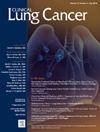DARES: A Phase II Trial of Durvalumab and Ablative Radiation in Extensive-Stage Small Cell Lung Cancer
IF 3.3
3区 医学
Q2 ONCOLOGY
引用次数: 0
Abstract
Background
Immunotherapy in combination with chemotherapy is first-line treatment for patients with extensive-stage small-cell lung cancer (ES-SCLC). Growing evidence
suggests that radiation, specifically stereotactic body radiation therapy (SBRT), may enhance the immunogenic response as well as cytoreduce tumor burden. The primary objective of the study is to determine the progression free survival for patients with newly diagnosed ES-SCLC treated with combination multisite SBRT and chemo-immunotherapy (carboplatin, etoposide, and durvalumab).
Methods
This is a multicenter, single arm, phase 2 study. Patients with treatment-naïve, ES-SCLC will be eligible for this study. Patients will receive durvalumab 1500mg IV q3w, carboplatin AUC 5 to 6 mg/mL q3w, and etoposide 80 to 100 mg/m2 on days 1 to 3 q3w for four cycles, followed by durvalumab 1500mg IV q4w until disease progression or unacceptable toxicity. Ablative radiation will be delivered 1 to 4 extracranial sites in 3 or 5 fractions, determined by location, during cycle 2. The primary endpoint is progression-free survival, measured from day 1 of chemoimmunotherapy. Secondary endpoints include grade ≥3 toxicity by CTCAE v5.0 within three months of RT, overall survival, response rate, time to second line systemic therapy, and time to new distant progression.
Conclusions
Now that immunotherapy is an established part of ES-SCLC management, it is important to further optimize its use and effect. This study will investigate the progression-free survival of combined SBRT and chemo-immunotherapy in patients with ES-SCLC. In addition, the data from this study may further inform the immunogenic role of SBRT with chemo-immunotherapy, as well as identify clinical, biological, or radiomic prognostic features.
DARES:Durvalumab和消融放疗治疗广泛期小细胞肺癌的II期试验。
背景:免疫疗法联合化疗是广泛期小细胞肺癌(ES-SCLC)患者的一线治疗方法。越来越多的证据表明,放射治疗,尤其是立体定向体放射治疗(SBRT),可增强免疫原性反应并减少肿瘤负荷。该研究的主要目的是确定接受多部位 SBRT 和化疗免疫疗法(卡铂、依托泊苷和 durvalumab)联合治疗的新诊断 ES-SCLC 患者的无进展生存期:这是一项多中心、单臂、2 期研究。方法:这是一项多中心、单臂、2 期研究。患者将接受杜瓦鲁单抗 1500 毫克静脉注射,q3w;卡铂 AUC 5 至 6 毫克/毫升,q3w;依托泊苷 80 至 100 毫克/平方米,第 1 至 3 天,q3w,共 4 个周期;随后接受杜瓦鲁单抗 1500 毫克静脉注射,q4w,直至疾病进展或出现不可接受的毒性。在第 2 个周期,将根据部位分 3 或 5 次对 1 至 4 个颅外部位进行消融放射治疗。主要终点是无进展生存期,从化疗免疫疗法的第1天开始计算。次要终点包括RT后三个月内CTCAE v5.0≥3级毒性、总生存期、反应率、二线系统治疗时间和新的远处进展时间:既然免疫疗法已成为 ES-SCLC 治疗的一部分,那么进一步优化其使用和效果就显得尤为重要。本研究将对ES-SCLC患者联合SBRT和化疗免疫疗法的无进展生存期进行调查。此外,本研究的数据还可进一步说明SBRT联合化疗免疫疗法的免疫原性作用,并确定临床、生物学或放射学预后特征。
本文章由计算机程序翻译,如有差异,请以英文原文为准。
求助全文
约1分钟内获得全文
求助全文
来源期刊

Clinical lung cancer
医学-肿瘤学
CiteScore
7.00
自引率
2.80%
发文量
159
审稿时长
24 days
期刊介绍:
Clinical Lung Cancer is a peer-reviewed bimonthly journal that publishes original articles describing various aspects of clinical and translational research of lung cancer. Clinical Lung Cancer is devoted to articles on detection, diagnosis, prevention, and treatment of lung cancer. The main emphasis is on recent scientific developments in all areas related to lung cancer. Specific areas of interest include clinical research and mechanistic approaches; drug sensitivity and resistance; gene and antisense therapy; pathology, markers, and prognostic indicators; chemoprevention strategies; multimodality therapy; and integration of various approaches.
 求助内容:
求助内容: 应助结果提醒方式:
应助结果提醒方式:


